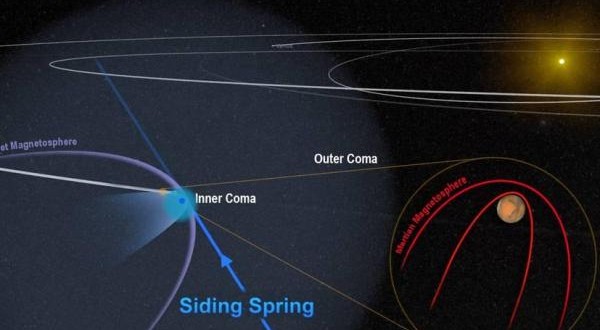Remember Comet Siding Spring? In October 2014, the comet soared past Mars at about 87,000 miles away. Space agencies with orbiters around the planet reoriented them to protect against the flyby.
Data collected by the MAVEN probe’s magnetometer suggest the flyby momentarily threw the Martian magnetosphere into chaos.
“We think the encounter blew away part of Mars’ upper atmosphere, much like a strong solar storm would.” Jared Espley, a MAVEN science team member at NASA’s Goddard Space Flight Center, said in a news release.
Unlike Earth, which a boasts an magnetic field generated from within, Mars’ magnetic field is created by the interaction between its plasma-rich upper atmosphere and solar winds. It is considerably weaker than Earth’s magnetic field.
Most comets boast a magnetic field similar to Mars — generated by the interaction between charged plasma particles in their coma and solar winds.
In 2014, when comet Siding Spring passed within 87,000 miles of Mars, its coma nearly touched the Martian surface. The comet’s magnetic field merged with and overwhelmed Mars’ much weaker magnetosphere.
“The main action took place during the comet’s closest approach, but the planet’s magnetosphere began to feel some effects as soon as it entered the outer edge of the comet’s coma,” Espley explained.
The first effects were minor ripples and waves pulsing across the Martian magnetosphere. As the comet’s coma penetrated the atmosphere, however, Mars’ magnetic field was plunged into chaos.
Researchers hope studying the interactions between the two magnetic fields will aid their understanding of how solar winds and solar storms interact with the magnetospheres of both Mars and Earth.
Agencies/Canadajournal
 Canada Journal – News of the World Articles and videos to bring you the biggest Canadian news stories from across the country every day
Canada Journal – News of the World Articles and videos to bring you the biggest Canadian news stories from across the country every day



